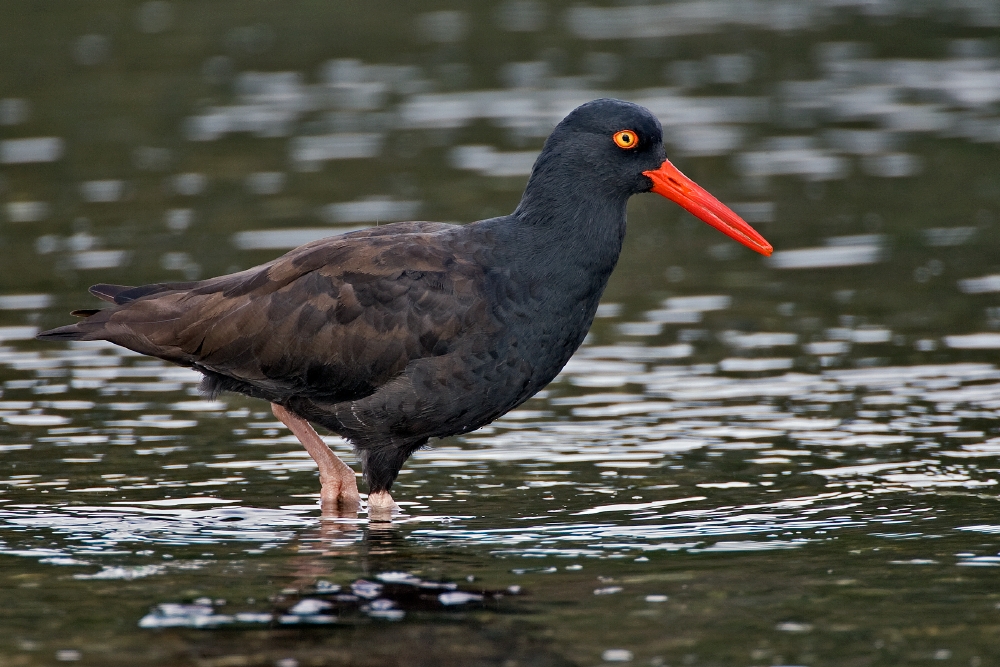- American Black Oystercatcher
Taxobox
name = American Black Oystercatcher
status = LC | status_system = IUCN3.1

image_width = 200px
regnum =Animal ia
phylum = Chordata
classis =Aves
ordo =Charadriiformes
familia =Haematopodidae
genus = "Haematopus"
species = "H. bachmani"
binomial = "Haematopus bachmani"
binomial_authority = Audubon, 1838)The American Black Oystercatcher, "Haematopus bachmani", also called Western Black Oystercatcher, is a conspicuous black bird found on the shoreline of western
North America . It ranges from theAleutian Islands ofAlaska to the coast of theBaja California peninsula .The American Black Oystercatcher is the only representative of the
oystercatcher family (Haematopodidae) over most of its range, overlapping slightly with theAmerican Oystercatcher ("H. palliatus") on the coast of Baja California. Within its range it is most commonly referred to as the Black Oystercatcher, although this name is also used locally for theBlackish Oystercatcher and theAfrican Black Oystercatcher . Its scientific name is derived byJohn James Audubon from that of his friendJohn Bachman .Although the species is not considered threatened, its global population size is estimated between 8,900–11,000 individuals. The Black Oystercatcher is a species of high conservation concern throughout its range (U.S., Canadian, Alaskan, and Northern & Southern Pacific Shorebird Conservation Plans), a keystone indicator species along the north Pacific shoreline, a management
indicator species in theChugach National Forest , and a U.S. Fish & Wildlife Service focal species for priority conservation action.Description
The American Black Oystercatcher is a large entirely black shorebird, with a long (9 cm) bright red bill and pink legs. It has a bright yellow iris and a red eye-ring. Its plumage varies slightly from north to south, being darker further north.
Behavior
The American Black Oystercatcher is restricted in its range, never straying far from shores, in particular favoring rocky shorelines. It has been suggested that this bird is seen mostly on coastal stretches which have some quieter embayments, such as
jetty protected areas. It forages in theintertidal zone , feeding on marineinvertebrate s, particularlymollusc s such asmussel s,limpet s andchiton s. It will also takecrab s,isopod s andbarnacle s. It hunts through the intertidal area, searching for food visually, often so close to the water's edge it has to fly up to avoid crashing surf. It uses its strong bill to dislodge food and pry shells open.The American Black Oystercatcher is a territorial bird during the nesting season, defending a foraging and nesting area in one territory. Some pairs have been recorded staying together for many years. Nests are small bowls or depressions close to the shore in which small pebbles and shell fragments are tossed in with a sideward or backard flick of the bill.
Around 2 to 3 eggs are laid in this nest, these are hardy and can even survive being submerged by a high
tide . Incubation takes around 26-28 days. The chicks are capable of leaving the nest after one day, and will stay in the territory for a long time after fledging (40 days). The fledged juveniles will stay in the territory until the next breeding season. If the parents migrate, that year's chicks will migrate with them; this happens more often in the north of the range.References
* Database entry includes justification for why this species is of least concern
* Black Oystercatcher, "The Birds of North America" No 155 B. Anders & G. FalxaExternal links
* [http://ibc.hbw.com/ibc/phtml/especie.phtml?idEspecie=1370 American Black Oystercatcher videos] on the Internet Bird Collection
* [http://vireo.acnatsci.org/search.html?Form=Search&SEARCHBY=Scientific&KEYWORDS=haematopus+bachmani&showwhat=images&AGE=All&SEX=All&ACT=All&Search=Search&VIEW=All&ORIENTATION=All&RESULTS=24 "Black Oystercatcher"-"Haematopus bachmani" photo gallery] VIREO-(includes picture of egg clutch)
Wikimedia Foundation. 2010.
